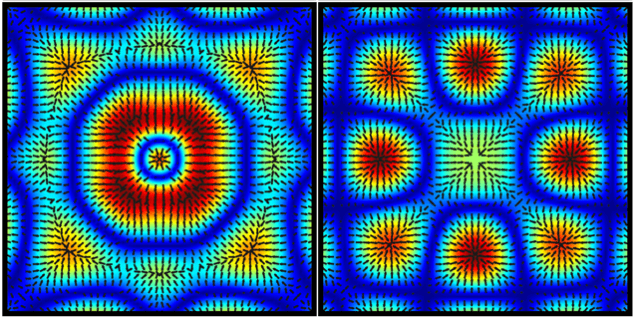
The behaviour of some particles on the vibrating surfaces of Chladni plates is reversed underwater, a new study reveals. The discovery was made by Kourosh Latifi, Harri Wijaya, and Quan Zhou at Aalto University in Finland. They observed that glass beads on a submerged vibrating plate move towards antinodes, where the plate’s amplitude of vibration is highest. The underwater effect could be useful in a variety of medical and biological applications, including the manipulation of living cells.
In 1787 the German physicist Ernst Chladni put sand on a vibrating plate and observed that the grains settle on the nodal lines where the plate’s amplitude of vibration is zero. In contrast, he observed that finer particles move towards the plate’s antinodes where the amplitude is a local maximum.
A century later, Michael Faraday explained both behaviours. He concluded that the vibrations cause the larger grains to move laterally across the plate until they reach a node – where they no longer get lateral kicks and therefore remain in place. As for why the smaller particles did the opposite, Faraday argued that air currents just above the plates tend to push the lighter particles towards the antinodes – an effect known as acoustic streaming.
Drag effect
In their new study, Zhou’s team observed that relatively large (750 µm-diameter) glass beads migrate to antinodes when the plate is submerged in water. This occurs, they argue, because the fluid drag experienced by the beads makes it more difficult for them to jump up from the plate’s surface. At the same time, they are forced to move laterally by both travelling waves on the plate’s surface and gravity (the latter is a result of the plate being bent up and down). Over one complete cycle of oscillation, they showed, the net horizontal force is always directed towards the plate’s antinodes. They also found that the beads can move in circles when the plate is vibrated at non-resonant frequencies.
Using their observations, Zhou and colleagues created a statistical model to predict the locations of the glass beads across a wide spectrum of vibration frequencies. Then they used their model to create complex combinations of both resonant and non-resonant frequencies that achieved the dynamic control of the motions of both individual and groups of particles. This allowed them to direct a single bead through a maze; to simultaneously move two beads along both L- and C-shaped paths; and to split a large cluster of beads in half.
The technique is relatively simple because it uses just one vibrational source to produce complex particle motions. If scaled-down to work on microscopic objects such as living cells and other tiny objects, it could be extremely useful for biological and medical applications. According to the team, possible applications include biotechnologies and tissue engineering, pharmaceutical research and microsystem assembly.
The study is described in Physical Review Letters.



